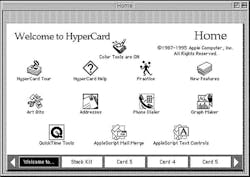Tim Musch didn’t buy a computer to create the CRM that would later become MarketSharp. He bought it to make newspaper ads. Nevertheless, he built a CRM—maybe the first ever.
From Ads to Applications
It was the 80s. Musch was working with his brother, who owned a wholesale/retail window business. “The plan was to get a computer to help with our newspaper ads,” he says. Musch purchased the original Macintosh with an Apple LaserWriter, a printer that was only on the market for three years.
Computers were still new to homes and businesses in the 80s, and people didn’t know their potential. Tim wasn’t planning to leverage the company computer for anything more than ad creation, but when he found a programming language tutorial included in the packaging, his acute business sense as well as his natural curiosity was piqued. It was called HyperCard.
The application, developed by Apple with a built-in programming language called HyperTalk, was a simple yet powerful programming platform that provided users with tools for creating graphics and text as well as stand-alone programs, according to a 1990 description in the Journal Educational Technology Magazine. Without formal training or instruction, Tim began teaching himself HyperCard using only the provided tutorial and his intellect. Soon he was using it to create.
Accomplishing Functionality
“My first program was three lines of code and it made the computer beep when the mouse was clicked,” he says. “I remember thinking, ‘Wow! You can do anything you want with these things.’”
I guess you could say we created a CRM before CRMs existed.
Letting company priorities guide his progress, Tim worked towards a mastery of HyperCard. “After some self-teaching, I began creating ways to have the computer help in other areas of our business,” he says, recalling working on the system in between window replacement appointments. “The first version of the software took three years to become functional. The most noticeable impact was an increase in business due to the software’s direct mail function that helped us obtain repeat business from past customers.”
CRMs hit the market in 1995 in the form of Siebel Systems’ Siebel CRM, created by company founders Thomas Siebel and Patricia House, who’d begun developing the system two years prior. Tim produced the first version of MarketSharp in 1991, even if he didn’t yet have the name. “Looking back, what we created was a CRM,” he says. “I guess you could say we created a CRM before CRMs existed.”
Getting Noticed and Becoming Marketsharp
Tim’s CRM becoming MarketSharp began by way of one of the business’s window suppliers. Having heard of the program, they invited Tim to speak and share what it could do. “There were about 100 people in the room,” he recalls. “Ninety-two thought I was from Mars, but eight of them raised their hands. They wanted one.”
As word got out, the program’s profile grew. In 1996, a group of home improvement entrepreneurs who’d heard of the software approached Tim and made him an offer to take it to market. He accepted, and so MarketSharp Software was created.
Today, Tim remains with his creation as the company’s director of business development. As of 2019, more than 4,000 home improvement companies use MarketSharp, helping them achieve $3.3 billion in installations. “Things have come a long way since that first ‘beep.’”

